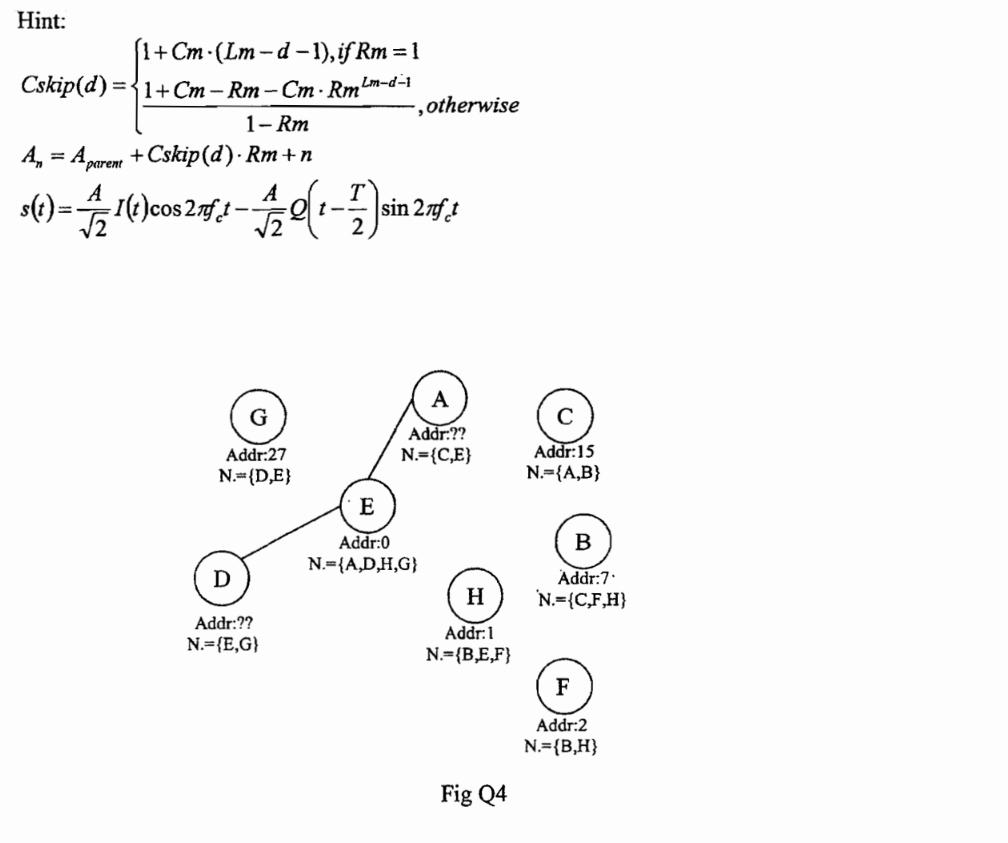Answered step by step
Verified Expert Solution
Question
1 Approved Answer
A ZigBee network is shown in Fig Q4, the address (Addr) and neighbor nodes (N) of each ZigBee nodes are indicated in Fig Q4.


A ZigBee network is shown in Fig Q4, the address (Addr) and neighbor nodes (N) of each ZigBee nodes are indicated in Fig Q4. Assume that the network is joined with maximum number of children and router and also has reached the maximum network depth. Perform the design of ZigBee network in the following steps with reasonable assumptions: a) Redraw the network in tree structure. (4 marks) b) Calculate the addresses of node A and D if tree address assignment is used. (7 marks) c) Identify the node(s) of ZigBee coordinator and router(s). d) List two possible nodes of ZigBee End device. e) Node B is trying to send a message to node C, list the route if tree routing is used; i. write the route if mesh routing is used give one advantage and one disadvantage of mesh routing. (4 marks) f) There is a zigbee application which is developed based on Non-beacon enabled network. Assumptions and information of this zigbee application are listed in Table Q4(B). Table Q4(Bi): Assumptions of ZigBee Applications 1. 2. CSMA/CA algorithm never reveals that the channel is busy Includes subsequent reception of associated acknowledgment 3. No retry is required 1 symbol period = 16,s 5. Fundamental data rate of modem = 250kbps 545 4. Table Q4(Bii): Information of ZigBee Applications Back-off Exponential value A unit of back-off period Clear Channel Assessment Size of acknowledgement frame header Size of acknowledgement frame payload Switching time of hardware 1. 2. ii. iii. 3.. 4. 5. 6. 7. 8. (3 marks) (1 marks) Size of data frame Maximum data payload of ZigBee 2 20 symbol period 8 symbol period 5 Bytes 10 Bytes 192s 40 Bytes 114 Bytes Compute the following parameters by using the information in Table Q4(B): (i) The worst case of channel access time, tac; (ii) Acknowledgment transmission time, t,; (6 marks) Hint: [1+Cm-(Lm-d-1), if Rm = 1 Cskip(d)=1+Cm-Rm-Cm - RmLm-d-1 1- Rm A = Aparent +Cskip (d). Rm+n A T s(t) = 21(1)cos 2nf 1-20(1-7) sin 2nfJ Qt-- t 2 Addr:27 N.={D,E} D Addr:?? N.=(E,G) otherwise Addr:?? N.={C,E} E Addr:0 N.={A,D,H,G} H Addr:1 N.={B,E,F} Fig Q4 Addr:15 N.={A,B} B Addr:7 N.={C,F,H} O F Addr:2 N.= {B,H}
Step by Step Solution
There are 3 Steps involved in it
Step: 1
Since the image contains several questions regarding ZigBee networks I will address each in the order they are presented a Redraw the network in tree structure To redraw the network in tree structure ...
Get Instant Access to Expert-Tailored Solutions
See step-by-step solutions with expert insights and AI powered tools for academic success
Step: 2

Step: 3

Ace Your Homework with AI
Get the answers you need in no time with our AI-driven, step-by-step assistance
Get Started


